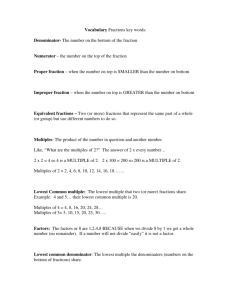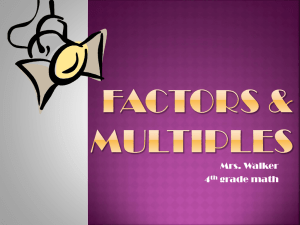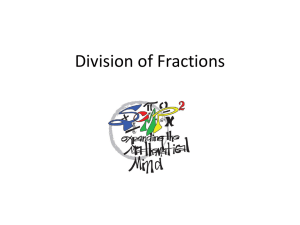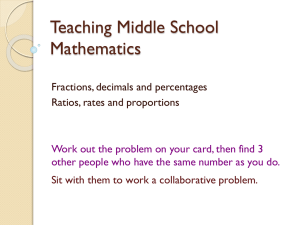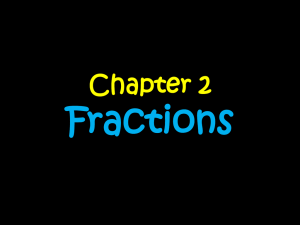File
advertisement
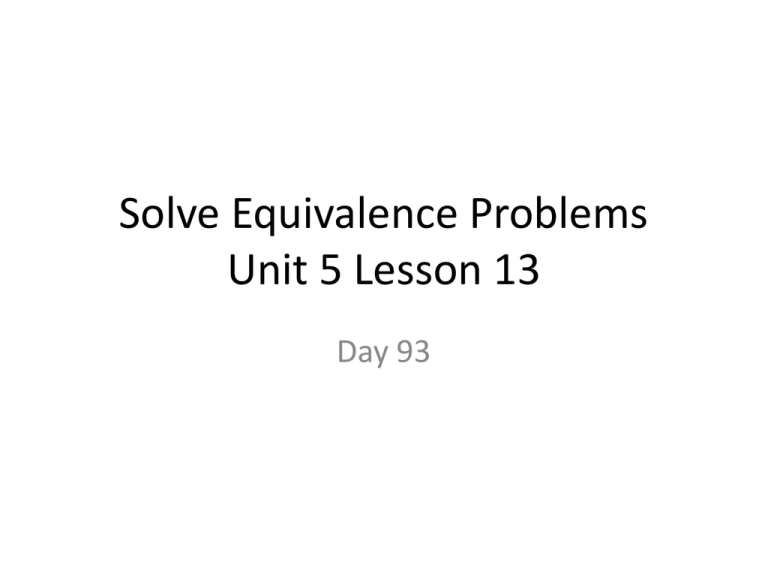
Solve Equivalence Problems Unit 5 Lesson 13 Day 93 Warm Up Reggie was building a design using counters. He put 9 in the first row, 17 in the second row and 25 in the third row. If he continued this pattern, how many counters would he have in the first five rows? • I need a volunteer to come to the board and write a chain of equivalent fractions. • How are these fraction chains helpful? 8 12 12 18 6 9 16 24 2 3 10 15 14 21 • I need a girl to come and circle on of the fractions in the fraction chain. • Write a G above the fraction. • I need a boy to come and circle on of the fractions in the fraction chain. • Write a B above the fraction. • Who gets more slices of the giant pizza, the girl or the boy? • Who gets larger slices of the giant pizza, the girl or the boy? • Who gets the larger amount, the girl or the boy? Why? • How do you know their two fractions are equivalent? • Let’s erase these fractions and repeat the entire activity by a boy and girl choose two different fractions. Remember… A larger denominator means smaller shares This was proven in the activity we just completed!! 5 • • • • n 8 24 N = the unknown numerator Everyone write a value for n in your notebook. What if we wanted to change 5/8 to a fraction with 24 as the denominator? What would be the multiplier be? Why? What would you multiply the numerator, 5, by to get an equivalent fraction? Why? 9 12 3 d • N = the unknown numerator • Everyone write a value for n in your notebook. • We want to change 9/12 to a fraction with 3 as the numerator. What will the divisor be? Why? • What will you divide the denominator, 12, by to get an equivalent fraction? Why? More Equivalence Problems We will share our work on the board. Be ready to explain if you had to simply or unsimply. 3 n 7 5 40 8 10 2 42 d 49 15 28 20 d 32 8 n 63 7 7 90 n d Solve problems 1-12 on page 205 in your hard back book!!! When might you want to simplify a fraction? • To find the simplest form of a fraction, you just keep dividing top and bottom by a common factor. Sometimes this might take 2 or 3 steps: 90 126 ÷3 ÷3 30 42 ÷2 10 14 5 7 • Complete #13 & 14 on page 205 • Complete page 206! Factors and Common Factors • What is a factor of a number? • Let’s think about the number 28. What are the factors of 28? • What number is a factor of every whole number? • What property helps us know this? • Identity Property of Multiplication Let’s think about the numbers 42 and 28. • What are the factors of 42? • The factors we just of 28 where: • 1, 2, 4, 7, 14, 28 • What factors are common to both lists of factors? • What is the greatest common factor in both lists? Greatest Common Factor (GCF) • Find the greatest common factors of: – 12 and 15 – 20 and 24 – 33 and 66 Multiples and Common Multiples Factors • What is a multiple of a number? • 4: – Why is 4 a multiple of 4? • How can we find other multiples of 4? • What are the first 10 multiples of 4? Common Multiples Factors • Multiples of 4: 4, 8, 12, 16, 20, 24, 28, 32, 36, 40 • Write the multiples for 3 • 3: 3, 6, 9, 12, 15, 18, 21, 24, 27, 30 • What multiples are common to both 3 and 4? Least Common Multiple (LCM) • What is the least (smallest) common multiple in both list of multiples? Solve and Discuss • Find the common multiples and LCM of each pair: 5 and 10 2 and 3 Homework •Homework and Remembering page 129
